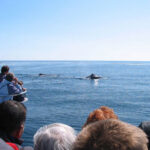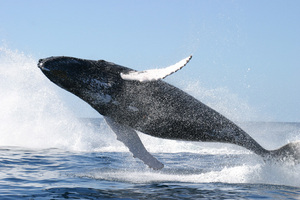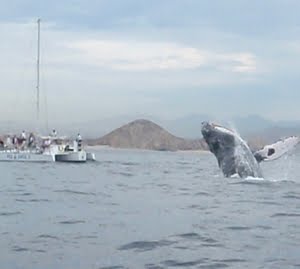Soon my husband will ask me, “What do you want for your birthday?” My common response is, “I want to go whale watching.” This was never a problem until a couple of years ago, when we moved to Kansas. Then I made a horrible discovery. There are no whales in Kansas!
I lived San Diego County for eight years, and twice a year my husband and I would take advantage of one of the many whale-watching trips that are offered in the area. We usually opted for the trip offered by Helgrens’ Sportfishing in Oceanside, California. We did this for two reasons; one it was five minutes from home, and two, it only took five minutes to get out of the harbor. In contrast, expeditions leaving from San Diego Harbor take much longer to clear the harbor. The San Diego Harbor itself can be an interesting sightseeing tour, but if your main interest is seeing whales, the Oceanside port is more desirable.
Gray Whale Facts
Gray whales make a round trip migration of 10,000 miles or more every year, from the birthing lagoons in Baja Mexico to their arctic feeding grounds. They usually travel close to the shoreline, which makes it easy to see them, even if you are standing on shore. What you will most likely see first is their blow, or spout. This occurs when the whale blows warm, moist air out of its lungs that combines with the colder, ocean air. The result is a 13-15-foot column of heart-shaped spray, which can last for up to 5 seconds. It is this spout that whale watchers are seeing when they yell out, “there she blows!”
You can recognize a gray whale by its size, shape, and markings. A gray whale has dorsal humps or knuckles rather than a fin. They are mottled gray in color, which comes from both natural coloration, and white patches of scars left by parasites and barnacles that attach themselves to their skin. They are not particularly beautiful to behold, although I suppose their mothers’ think differently. The gray is also smaller than many whales, averaging 45-50 feet long.
What Are the Signs a Whale is Near?
Whenever my husband and I would go whale watching, we always tried to stand in the bow. No, we were not trying to emulate Leonardo DiCaprio and Kate Winslet in the movie Titanic. We like to stand there to get the best view of any whales we show up. It is always fun to be the first one to see the blow and point it out to other passengers. Whales tend to dive deep for 3-6 minutes, come up for air, and then dive deep again, although they can stay submerged for much longer. You may see their knuckled back before or after the blow, and you can also watch for a smooth, oval patch of water, called a “footprint,” which occurs right after a whale submerges.
If you are lucky, you might see a whale “fluke,” when they dive deeply and toss that massive tail up in the air. Sometimes you run across a whale that wants to show off and will fluke for you several times. When that happens, we always offer our respectful thanks to this incredible creature for this great honor. In more rare cases you might see a whale breach, at which time they hurl themselves out of the water and splash back in. I’m still waiting for that very exciting sight!
In our more than dozen trips, we have only had one trip where we didn’t see any whales, but we did see lots of dolphins, harbor seals sitting on the bell buoy, formation flying pelicans, and a multitude of seagulls. The particular day it was so windy, it was possible we were cruising right next to a whale and did not see it due to the high waves.
Tips for Whale Watching Trips
It is always advisable to dress in layers when venturing out on the ocean, for the temperature can vary. The weather may be warm on-shore, but the temperature can drop dramatically once you leave the protected harbor. This is especially true since the whale watching season runs from October to March. I also recommend sturdy non-skid shoes, since the decks can become slippery. On the very windy day I described above, we had a passenger fall when we suddenly hit the choppy waters at the head of harbor. We had to return to the dock to get medical attention for this person.
Since I am prone to seasickness, I also take a Dramamine so that I can totally enjoy the adventure. They have a newer, non-drowsy formula, which is great, because normally I would sleep all the way home!
Gray Whales Are Making a Comeback
The only predators a gray whale has are humans and orcas. Gray whales were nearly hunted to extinction, but have been making a comeback since they were granted protection by an international ban on the commercial harvest of gray whales in 1946. Additional laws have since been passed that have helped the gray whales make further increases in population. They were removed from the endangered species list in June 1994.
But, surprisingly, avid whale watchers have reported that they are not seeing as many whales passing by than they have in previous years. According to an article entitled, “How Come We Don’t See as Many Whales as We Used To?” by Park Ranger George D. Herring at the Cabrillo National Monument at Point Loma, this observation is accurate. Dr. Jim Sumich, a whale biologist with Grossmont College in San Diego County believes there are many reasons for this, including water quality, boat traffic, or changes in migration routes. But the factor having the most impact is not, as you might expect, whale watching tour boats. It is more likely an increased number of private boats that do not always observe the Federal laws regarding whale watching.
Cetacean Watching Code of Conduct
When I first moved to the San Diego area, I expressed a desire to visit Sea World, but after seeing my first whale in the wild, I no longer had any desire to see a whale in captivity. Watching them in their natural habitat is much more rewarding than seeing them jump out of the water for a fish held by a handler. However, as guests in their home, we owe it to these magnificent creatures to follow certain rules when visiting. We should always take our cues from their behavior, and back off if they seem disturbed or harassed. The Whale and Dolphin Conservation Society publishes this “Cetacean Watching Code of Conduct..”
1. KEEP your distance. Never go closer than 100m (200m if another boat is present)
2. NEVER drive head on to, or move between, scatter or separate dolphins. If unsure of their movements, simply stop and put the engine into neutral.
3. PLEASE spend no longer than 15 minutes near the animals
4. SPECIAL care must be taken with mothers and young
5. MAINTAIN a steady direction and slow “no wake” speed
6. NEVER try to swim with cetaceans for your safety and theirs
7. DO NOT dispose of any rubbish, litter or contaminants at sea
Whale Watching Benefits
The benefits of whale watching are many, both to humans and the whales. When I was suffering from a bout of depression, my husband announced, “This weekend we are going whale watching.” Just being out on the ocean in the fresh air and observing the wild creatures in their own environment was the best therapy for me. It is also good for the whales, because it raises the awareness of the public of the need for conservation practices that will continue to protect these majestic creatures for years to come.
Sources:
Helgren’s Sportfishing
Gray Whales Journey North
http://www.learner.org/jnorth/tm/gwhale/MigrationRoute_Map.html
Website: The Birch Aquarium at the Scripps Institute of Oceanography
http://aquarium.ucsd.edu/Education/Learning_Resources/Creature_Features/Gray_Whales/index.php
Website: San Diego Natural History Museum
http://www.sdnhm.org/fieldguide/mammals/esch-rob.html
Article: “How Come We Don’t See as Many Whales as We Used To�”
by Park Ranger George D. Herring
Website: What to Look For: From National Park Service, Cabrillo National Monument
http://www.nps.gov/archive/cabr/whales.html
Website: San Diego Natural History Museum
http://www.sdnhm.org/fieldguide/mammals/esch-rob.html
Website: Wikipedia – Gray Whale
http://en.wikipedia.org/wiki/Gray_Whale
Website: Whale and Dolphin Conservation Society
http://www.wdcs.org/dan/publishing.nsf/allweb/E703F6E03C76F42C80256FD900330805




